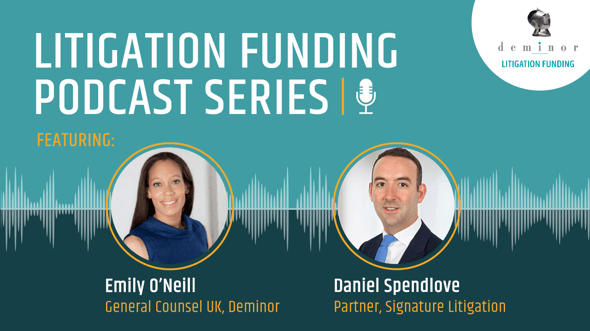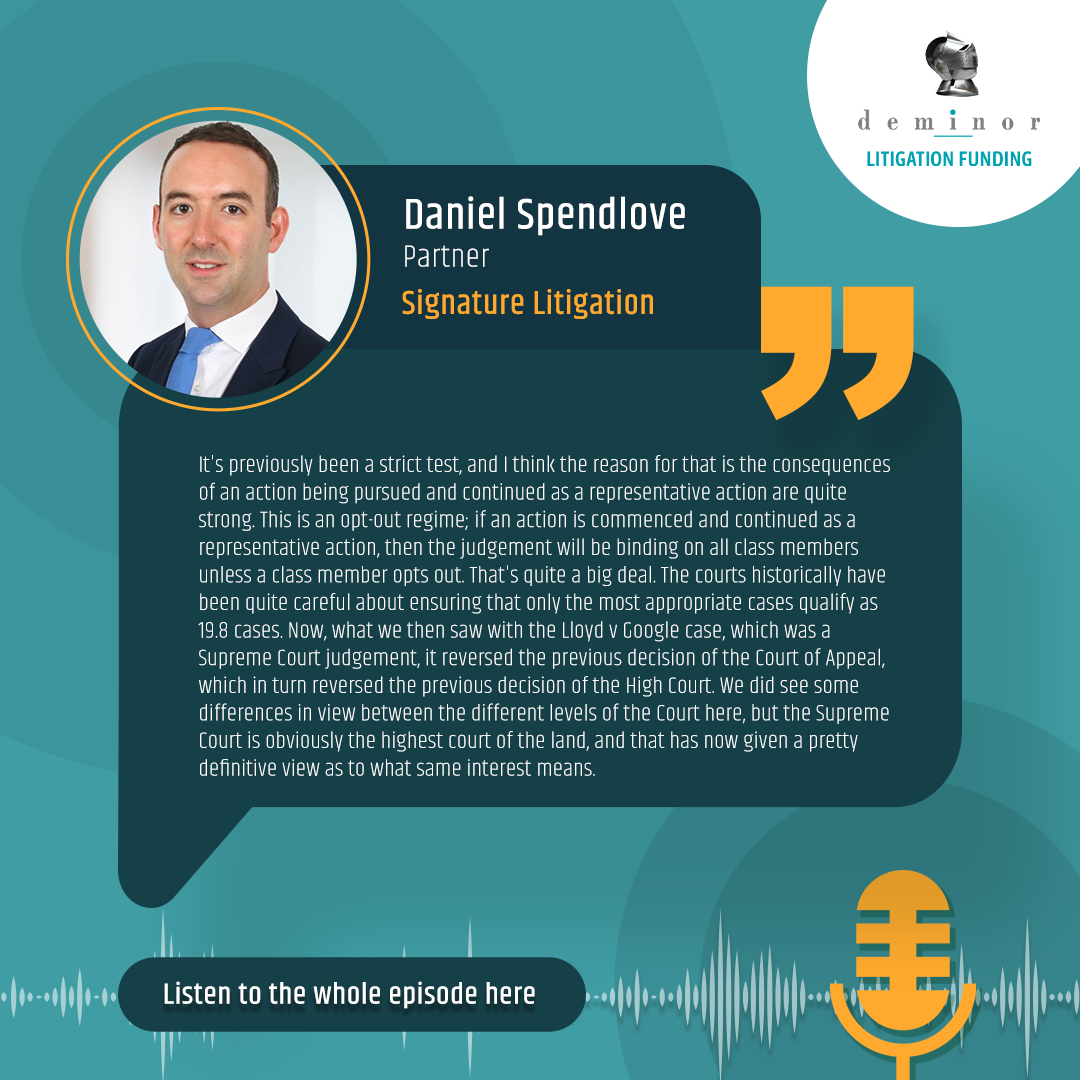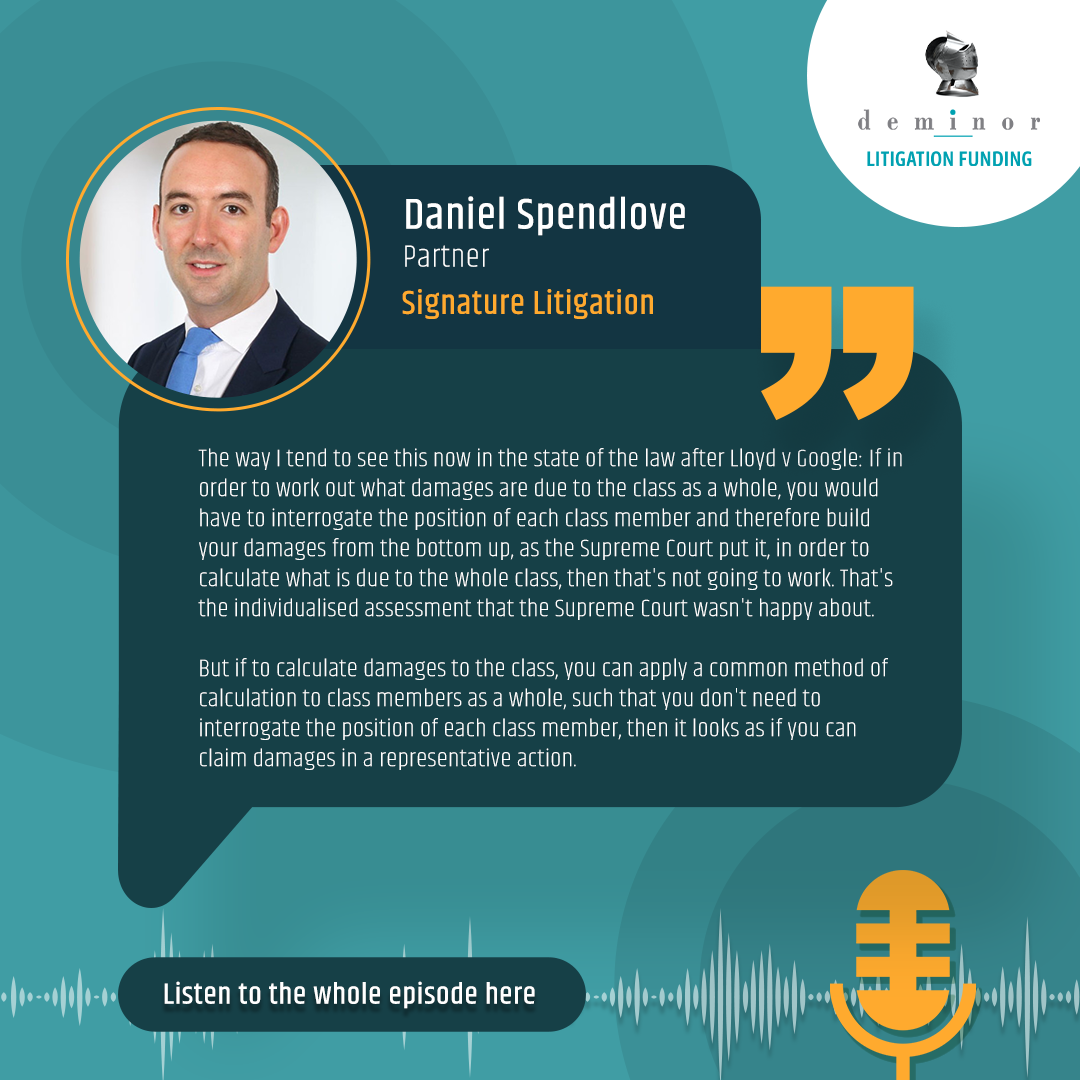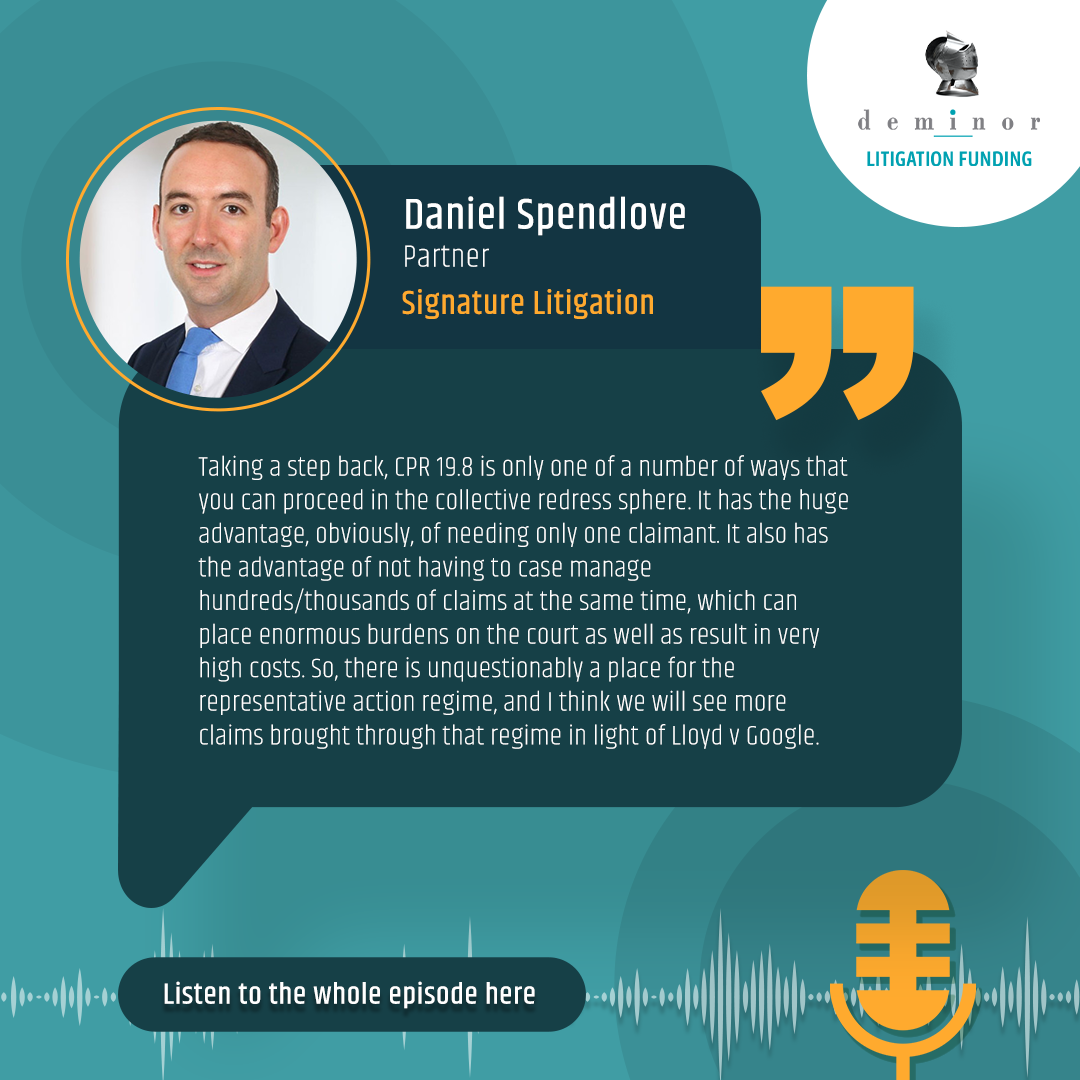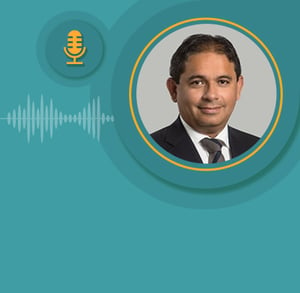In this podcast series, Emily O'Neill General Counsel UK for Deminor Litigation Funding, undertakes interviews with global professionals to discuss different aspects of the litigation funding process. We have already considered the importance of the client in litigation funding as well as the business case for funding.
Deminor welcomes you to join this conversation as we summarise the key elements of the conversations between Emily O'Neill and these experts, as captured in the podcast transcripts below.
Podcast Preface:
Deminor General Counsel UK, Emily O'Neill (EON), speaks with Daniel Spendlove (DS), Partner at Signature Litigation. Daniel focuses on complex and high-value commercial litigation and arbitration and has been involved in several cases which have featured in The Lawyer’s “Top 20 Cases of the Year”. He is currently acting for Commission Recovery Limited in bringing a representative claim under CPR 19.8 against Marks & Clerk LLP and its affiliated partnership, Long Acre Renewals.
In this interview, Emily discusses with Daniel the representative actions regime in England and Wales and the thresholds to be met to be able to bring a claim as a representative action.
Podcast Transcript:
EON – Litigation funding is often required to launch and run a representative action – please can you start by outlining the representative action regime that we have in the UK?
DS – The representative action regime that we have here in England and Wales is really the closest thing that we have to the US opt-out class action regime. And, of course, we have a bespoke regime for opt-out competition claims. So, when we're talking about representative actions in this podcast, we're obviously talking about non-competition claims.
The representative action regime for non-competition claims is set out in CPR 19.8, and this was recently renumbered – it used to be known as CPR 19.6, but I will refer to it with its up-to-date numbering, which is 19.8. The test in CPR 19.8 is a mercifully short one, and it provides that where more than one person has the same interest in a claim, the claim can be begun, or the court can order that it be continued by a representative who shares that same interest. The key is whether the representative who is seeking to commence the claim as a representative action shares the same interest as representatives, i.e. other members of the class. And it's that same interest test which has received quite a bit of judicial attention in recent months and years.
EON – What does same interest actually mean in practice? What have the courts said around this in the actions that they've considered so far?
DS – It's previously been a strict test, and I think the reason for that is the consequences of an action being pursued and continued as a representative action are quite strong. This is an opt-out regime; if an action is commenced and continued as a representative action, then the judgement will be binding on all class members unless a class member opts out. That's quite a big deal. The courts historically have been quite careful about ensuring that only the most appropriate cases qualify as 19.8 cases. Now, what we then saw with the Lloyd v Google case, which was a Supreme Court judgement, it reversed the previous decision of the Court of Appeal, which in turn reversed the previous decision of the High Court. We did see some differences in view between the different levels of the Court here, but the Supreme Court is obviously the highest court of the land, and that has now given a pretty definitive view as to what same interest means.
I think most people in the market feel that the Supreme Court, whilst it decided that the Lloyd v Google case could not proceed, at least when it came to quantum on a representative basis, largely relaxed the same interest test. The way it described the same interest test as operating was to ask whether there is a conflict between class members – and that's quite an interesting articulation of the rule. The Supreme Court felt that provided there wasn't a conflict of interest between class members, then the same interest test, subject to judicial discretion, could be satisfied. For example, the fact that a defendant may have defences to a claim from some class members, rather than the class as a whole, did not preclude the same interest test being met. Suddenly, we are seeing a world in which you may have some differences between class members and actually, the case can proceed under CPR 19.8, provided that there is no conflict between them. You can have differences. The key is to make sure that those differences don't result in a conflict between the class members. So that's the first way in which the same interest test was clarified, if not relaxed.
The second way was when it came to damages. I think a lot of legal commentators and a lot of lawyers always felt that any claim for damages, by which I mean compensatory damages, could never be pursued under CPR 19.8. The Supreme Court had something to say about that. The claim in Lloyd v Google was held to not be one that could proceed under CPR 19.8. In that case, Mr Lloyd was seeking damages for a data breach, so it was a particular type of damage that was being claimed. Whilst the Supreme Court said, no, we can't have that - what it did say is that there are various other types of cases where you might well be able to seek damages and the critical question is whether or not the calculation of those damages would require an individualised assessment.
That's really where we are now with the law. The way I tend to see this now in the state of the law after Lloyd v Google: If in order to work out what damages are due to the class as a whole, you would have to interrogate the position of each class member and therefore build your damages from the bottom up, as the Supreme Court put it, in order to calculate what is due to the whole class, then that's not going to work. That's the individualised assessment that the Supreme Court wasn't happy about.
But if to calculate damages to the class, you can apply a common method of calculation to class members as a whole, such that you don't need to interrogate the position of each class member, then it looks as if you can claim damages in a representative action. Another way of describing that is what the Supreme Court called the top-down approach - you apply a common method of calculation to look at what damage was suffered by the class as a whole; you don't need to get on the telephone to individual class members to work that out. Helpfully, the Supreme Court, Mr Justice Leggett, gave some examples of the sorts of cases that would fall within that top-down approach where you don't have to interrogate each individual class member to work out what they lost.
One example is where every class member was charged, wrongly and unlawfully, a fixed fee. Again, in that case, you don't need to interrogate every single class member to work out what the total amount due to the class is. You know what the fixed fee was, you know how many class members there were, and you do the maths.
Another example cited by the Supreme Court was where every class member bought the same product with the same defect, which reduced its value by the same amount. Again, in that case, you don't need to interrogate the position of every class member, you can work out what compensatory damages are owed to the class as a whole. You can see that there might be a number of consumer claims that fall into those sorts of categories, where the top-down approach is a means by which you can calculate what is due to the class as a whole. A lot of the press that followed Lloyd and Google commented on how it wasn't a great step forward for the representative action regime. Actually, properly analysed, the Supreme Court gave us some pretty useful guidance. It's useful both to claimants looking to bring these claims and also obviously parties looking to defend them as to what same interest means. And I think it is probably fair to say that the test is now a much clearer one than we had before and has obviously provided useful guidance for other cases that are proceeding through the courts.
EON – I think the examples that the Supreme Court focused on were very much where you could apply the top-down approach and where the kind of harm to each of the members of the class would be the same.
DS – Yes. I think it's a great example of the Supreme Court wanting to be very practical. I think there is obviously a nervousness about CPR 19.8 potentially turning us into this sort of class action regime, call it ambulance chasing, where all of these claims suddenly get brought. I think the Supreme Court was quite mindful of that, and it was a good example of the Court balancing the interests of various parties. Clearly, we need some sort of representative action opt-out regime, but I think there's got to be some limits to that rule so that we don't encourage too much litigation.
EON – Do you think the regime is still applicable where you can carry out a top-down assessment and there are a class of claimants who don't all have the same level of harm? How would the Court approach, looking at that kind of quantum?
DS – I think if each class member has suffered a different amount of harm and you can assess that harm on a top-down basis or applying the common method of calculation, I think, in principle, you could proceed as a CPR 19.8 case. If you have to interrogate the position of each individual class member, I don't think you're going to be able to do it. In principle, as long as there's that common method of calculation, you may end up in a position where each class member has suffered a different loss, but as long as you can actually calculate that loss without interrogating each position, then I think it's permissible.
As the law currently stands under Lloyd v Google, and then under the later High Court decision of Prismall, the court there has said, you can't bring claims to recover data breach damages under the CPR 19.8 regime, because that necessarily involves an inquiry involving the participation of the class member as to how that particular data breach affected them.
I think the Court gave some illustrations of some people who would have been very affected by the data breach and may well have suffered all sorts of emotional and mental distress. And there might be some other people who, yes, were victims of the data breach, but who were just not affected in that same way. So that's an example of where the court is saying, look, everybody is necessarily going to suffer a different level of damage. The only way to ascertain what that damage is to require the participation of the class members, presumably to give evidence as to how the breach affected them. Those sorts of cases at the moment are looking difficult where you need the participation of class members. But there are some workarounds, it's not the end of the road for those cases.
The first workaround is the one that was identified by Lord Leggett in his judgement in Lloyd v Google, which is that you obtain through the representative action regime a judgement on liability and also a judgement that grants declaratory relief that damages are payable to the class. You don't get into the question of how damages are calculated. You can't come up with the number that's owed to the class, but you have a declaration that damages are payable. You would then have to move into a different regime in order to actually calculate what those damages are, both in respect of individual class members, but also to the class as a whole. Because you're going to need the participation of class members, you're likely then to need some sort of book build. You're going to need to effectively sort of recruit claimants and then interrogate them as to how they were affected individually by whatever unlawful conduct caused the harm. That, of course, and again, as Lord Leggett identified, is not such an attractive proposition for a funder because, as we know, book builds can be time-consuming, they can be expensive, and they rarely result in every single class member or affected person signing up to the claim - that can impact the economics of funding. But that is a way that you could go. I think there is a class of case unquestionably, and I think there's a number of cases that are more than viable in terms of liability judgments through 198 but are more challenging to get damages calculated through 19.8. That said, at least you have a liability judgment and that may well help the later book build in order to recruit claimants and give people an opportunity to collect at the end of it.
The second, you could just proceed on an opt-in basis from the beginning. In other words, you don't obtain your liability judgment through 19.8; you do a book build at the start, and then you apply for a group litigation order. I think we're seeing that GLOs sometimes are not needed for these types of cases. It is one means through which to case manage opt-in claims, but it's not the only one.
The third method would be, again, to sign everybody up in a book, build as many claimants as possible, and then end up with a bespoke set of case management orders. You might have a concurrent case management and trial under CPR 3.1 (2)(H). Or you might end up with an exemplar test claim scenario where, for the sake of argument, let's say it's 500 claims, you end up with 10/15 test claimants. You have a trial of preliminary issues by reference to those test claimants, and you may well then have findings on damages owed to those test claimants. But the idea is, once you've got those findings, that they're either binding on the wider group or they give helpful guidance to the just and efficient determination of the remaining claims. And the idea is that a settlement results shortly afterwards.
Taking a step back, CPR 19.8 is only one of a number of ways that you can proceed in the collective redress sphere. It has the huge advantage, obviously, of needing only one claimant. It also has the advantage of not having to case manage hundreds/thousands of claims at the same time, which can place enormous burdens on the court as well as result in very high costs. So, there is unquestionably a place for the representative action regime, and I think we will see more claims brought through that regime in light of Lloyd v Google. But I don't think many people will disagree with the fact that there are just a certain number of claims that are inherently unsuitable for the representative action regime. For those, you're looking at, the opt-in regime GLO multiple claims on the same claim form bespoke case management. There are lots of tools that the court has in its toolkit to deal with those sorts of claims. So, it's pretty flexible, and there are a number of options available to potential claimants.
EON – I think, as you said, the attraction of the 19.8 procedure for a funder is that you're capturing the entire class, and you don't need to fund or go through the book build process with the risk that has.
Stepping back and thinking about one representative, what are the characteristics that you look out for in selecting the representative to put forward under 19.8?
DS – Yeah, it's a less formal regime to the competition regime, and many other jurisdictions have a very prescribed process for how class representatives are selected and then confirmed by the court.
The English representative action regime certainly doesn't contain any statutory guidance as to how you select a class representative. The way it tends to go is as follows: Firstly, the class representative issues and serves its claim. It obviously identifies itself as the class representative, and a paragraph goes into the particulars of the claim, which identifies and informs the court and the defendant or the defendants that it proposes to be the class representative on behalf of a defined class and the class is then defined. So you start off by pleading your case, and it is then for the defendants to challenge the class representative's attempt to commence the claim as a representative action. And that's where, essentially, you end up, for all intents and purposes, in a certification process. Of course, the court will determine whether or not the same interest test is met. We will go through all of the hurdles that we've just talked about, but the court also has an inherent jurisdiction to allow or disallow the claim to proceed as a representative action.
So there's a very heavy discretionary element, and I think it's part of that discretionary inquiry that the court will consider whether this representative is suitable. And they need to be somebody who is able to represent the class as a whole and act in its best interests. Have they got a proper legal team? Is this somebody who can run the litigation effectively? It's a big responsibility to run litigation. In practice, whenever there is a challenge brought to a 19.8 claim proceeding, usually evidence is served both by the claimants and the defendants as to whether or not this class representative is suitable. And the court will determine that as part of its discretionary inquiry. If the answer is yes, I am content that this representative may represent the class, then it is, for all intents and purposes, certified as a class representative. There's no formal certification process, but the court grants an order that the claim may proceed as a representative action, and then away you go. You have then litigation brought and permitted under CPR 19.8, and you'll be heading into your first case management conference, and the usual directions will follow.

Litigation Funding Podcast Series - Next Steps and Further Information:
Thanks for joining Deminor's Litigation Funding Podcast Series as we dive deep into core topics in funding litigation.
Keep a lookout for our upcoming conversations as Deminor General Counsel UK, Emily O'Neill, speaks with several more experts to get their insights into different aspects of litigation funding.
If you would like to connect with either Emily or Daniel on LinkedIn, please click on the links below:
Emily O'Neill – Deminor General Counsel UK and Global IP lead
Daniel Spendlove – Partner at Signature Litigation
***
Further Reading:
- https://www.deminor.com/en/case-studies/co-funder-proposes-sharing-of-litigation-funding-risk-to-leverage-deminors-in-house-due-diligence-capability
- https://www.deminor.com/en/case-studies/financing-assertion-of-patents-protecting-manufacturing-processes
- https://www.deminor.com/en/case-studies/telecoms-patent-assertion-multi-jurisdictional-campaigns
- https://www.deminor.com/en/case-studies/canadian-innovative-start-up-preparing-for-a-david-v-goliath-litigation-funding-battle
- https://www.deminor.com/en/case-studies/whats-the-risk-assessing-the-risk-of-counter-assertion-by-the-defendant-in-patent-litigation
- https://www.deminor.com/en/case-studies/overstepping-the-mark-litigation-funding-trade-mark-infringement
- https://www.deminor.com/en/case-studies/lights-camera-action-recovering-damages-for-infringement-of-rights-in-a-short-film
- https://www.deminor.com/en/case-studies/recovering-damages-for-stolen-software-through-litigation-funding
- https://www.deminor.com/en/case-studies/funding-in-the-pharma-sector-/-investing-in-a-case-where-litigation-is-already-ongoing


